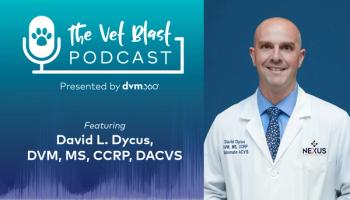
DVM renews role in changing practice
Stretched out off South Tampa's busy main line is a small animal practice so community integrated, some clients have been visiting for more than 30 years. Yet the bustling Veterinary Medical Clinic, Inc. is anything but quietly settled in its sub-tropic surroundings. Since its 1970s inception, Dr. Eddie Garcia has been building, both inside and out.
Stretched out off South Tampa's busy main line is a small animal practice so community integrated, some clients have been visiting for more than 30 years.
The Veterinary Medical Clinic in Tampa has afforded residents top-of-the-line small animal care for more than 30 years. Owner Dr. Eddie Garcia no longer makes daily rotations, leaving the responsibility in the hands of five associates and more than a dozen staffers.
Yet the bustling Veterinary Medical Clinic, Inc. is anything but quietly settled in its sub-tropic surroundings. Since its 1970s inception, Dr. Eddie Garcia has been building, both inside and out. Thirty-two years later, the one-time solo practitioner now employs five associates and a barrage of in-house staff servicing more than 7,000 active patients and pulling in about $2.5 million in gross earnings a year.
"I have a lot of competition, but this is one of the highest income areas in the city of Tampa," Garcia says. "It's very stable here; I'm seeing third-generation clients now."
Dr. Eddie Garcia
The executive chair
Relying on that consistency, Garcia feels comfortable being often absent from his hospital's rotation list and his traditional role as staff practitioner. Nowadays, the 60-year-old veterinarian primarily functions as company CEO, delegating responsibilities and heading up the hospital's latest venture - a 1,000-square-foot cat clinic expansion.
"I'm kind of like the chairman of the board (CEO)," Garcia says. "I spend the great majority of my time working on the practice rather than working in the practice."
Bird's-eye view
This hands-off approach from the hospital's inner workings gives Garcia an opportunity to take in the bigger picture, making sweeping changes when he deems necessary and growing with the times, he says.
The cat clinic, for example, came about after months of research, polling clients and visiting similar facilities. A year into planning, Garcia consolidated his retail grooming shop, which sat across from the hospital's parking lot, and sold it. He then gutted the building and installed a large staff recreation area, training center and three exam stations. The clinic opened last month.
More than 7,000 patients rely on care provided by the Veterinary Medical Clinic, including services offered by the facility's board-certified internist.
"It's exciting," he says. "I'm the (public relations) arm and the marketing arm for the clinic. I spend more time planning and bonding clients to the practice, improving client communication and making sure our name is always out there."
Increasing services
But with the new construction, Garcia hasn't lost sight of the lifeblood of his business - his general practice. Recently, he hired a full-time, board-certified internist to bring in some of the specialized services clients now expect.
"We don't have to refer a lot of our cases out; now we can treat them right here," he says. "We have several chemos going all the time. It's definitely nice to be able to provide that."
To make room for the equipment, Garcia reorganized the hospital's relatively tight 3,000-square-foot space. Somewhat unconventional, a phone receptionist now sits in a back office answering calls while two receptionists care for clients up front. All the while, a "flow coordinator" directs clients, handles walk-ins and tracks each doctor's schedule among three exam rooms and surgery suite.
Across the parking lot from this main building sits Dr. Eddie Garcia's latest project - a 1,000 square-foot cat clinic. The facility opened in June.
"The way I have it set up, it's so different from other hospitals," Garcia says. "Clients get quality time up front without the distraction of phones, and the flow coordinator is an extension of every doctor in every room."
Backing out slowly
With operations running smoothly, Garcia is comfortable spending weeks away from the hospital playing golf or traveling, which is one of his passions. Garcia's not talking retirement, he's just taking on different tasks in the business.
"Over the years, I've come up with and instituted protocols and procedures that afford the clinic the ability to function efficiently and effectively without me," he says. "I prefer to think I'm indispensable, but I'm not. I know things will go on without me."
And that's exactly how he likes it.
"Right now I have flexibility," he says. "What I'm really selling in this business is peace of mind; it's a veterinarian's product.
"I can sell that until I'm 80 or 90 years old."
Newsletter
From exam room tips to practice management insights, get trusted veterinary news delivered straight to your inbox—subscribe to dvm360.



